Strategic Management: Comparing Stakeholder, Entrepreneurial, Formal
VerifiedAdded on 2021/06/17
|16
|3677
|108
Report
AI Summary
This report provides a comprehensive analysis of three distinct approaches to strategic management: the stakeholder approach, the entrepreneurship opportunistic approach, and the formal structured approach. The stakeholder approach emphasizes the importance of considering the interests of all stakeholders, including customers, employees, and shareholders, in decision-making. The entrepreneurship opportunistic approach focuses on capitalizing on available opportunities and fostering innovation within the organization. The formal structured approach involves a systematic and planned method for achieving organizational objectives. The report delves into the viability, suggested benefits, implementation issues, and limitations of each approach, providing a comparative perspective on their strengths and weaknesses. It highlights how these approaches can be applied in various business contexts and offers insights into their practical implications for organizational success. The report also touches on the differences between strategic and operational management and how globalization has reshaped these concepts.

STRATEGIC MANAGEMENT 1
Approaches to Strategic Management
Name:
Institution:
Course:
Tutor:
Date:
Approaches to Strategic Management
Name:
Institution:
Course:
Tutor:
Date:
Paraphrase This Document
Need a fresh take? Get an instant paraphrase of this document with our AI Paraphraser
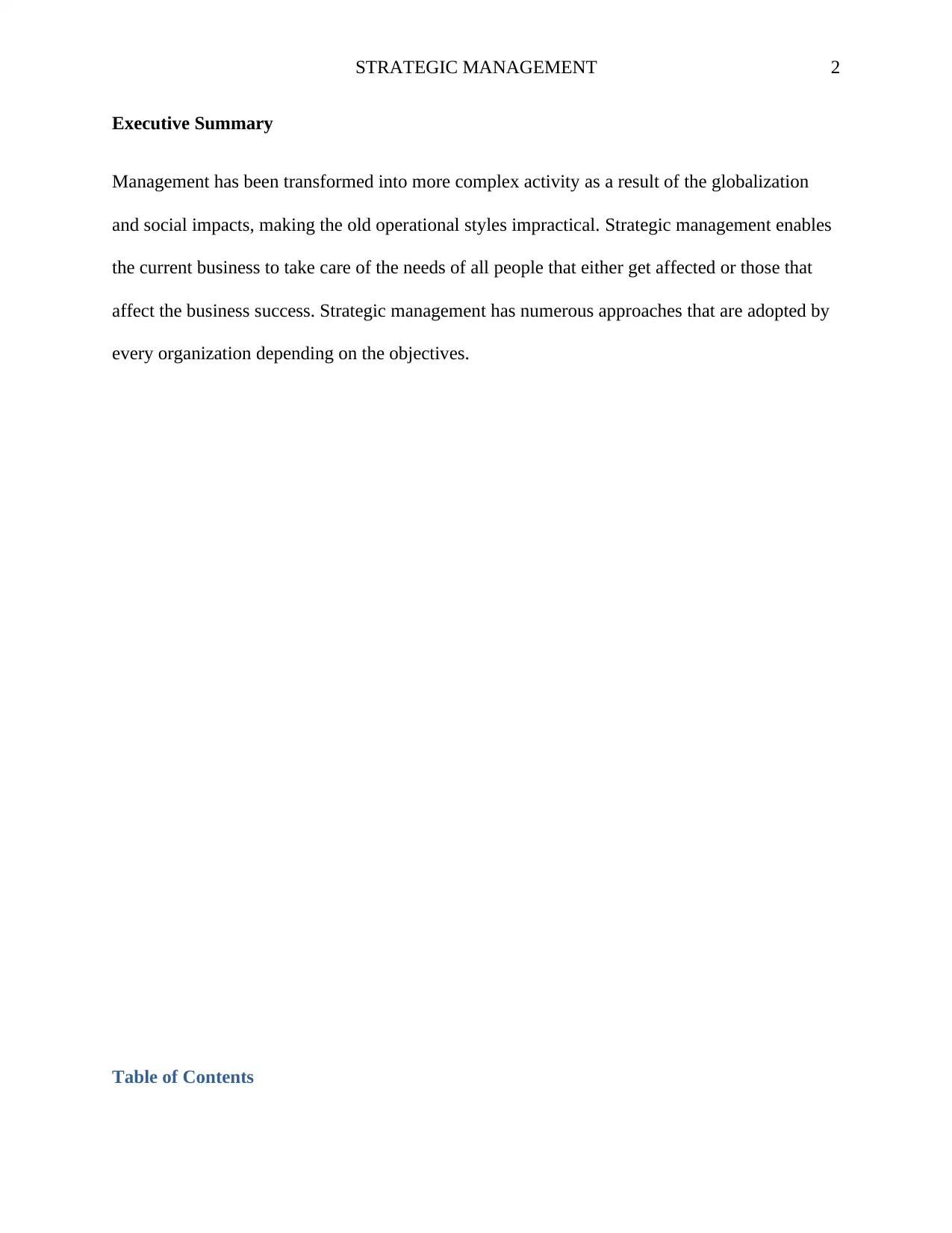
STRATEGIC MANAGEMENT 2
Executive Summary
Management has been transformed into more complex activity as a result of the globalization
and social impacts, making the old operational styles impractical. Strategic management enables
the current business to take care of the needs of all people that either get affected or those that
affect the business success. Strategic management has numerous approaches that are adopted by
every organization depending on the objectives.
Table of Contents
Executive Summary
Management has been transformed into more complex activity as a result of the globalization
and social impacts, making the old operational styles impractical. Strategic management enables
the current business to take care of the needs of all people that either get affected or those that
affect the business success. Strategic management has numerous approaches that are adopted by
every organization depending on the objectives.
Table of Contents

STRATEGIC MANAGEMENT 3
1.0 Introduction...........................................................................................................................................3
1.1.0 Differences between Strategic Management and Traditional Operational Management..............4
2.0 Stakeholder Approach...........................................................................................................................5
2.1.0 The viability of Stakeholder Approach............................................................................................5
2.2.0 Suggested Benefits of Stakeholder Approach.................................................................................5
2.3.0 Implementation Issues of Stakeholder Approach...........................................................................6
2.4.0 Limitations of Stakeholder Approach.............................................................................................6
3.0 Entrepreneurship Opportunistic Approach of strategic management..................................................7
3.1.0 Viability of Entrepreneurship Approach.........................................................................................7
3.2.0 Suggested Benefit of Entrepreneurship Approach.........................................................................8
3.3.0 Implementation Issues of Entrepreneurship Opportunity Approach..............................................8
3.4.0 Limitations of Entrepreneurship Opportunity Approach................................................................9
4.0 The Formal Structured Approach........................................................................................................10
4.1.0 Suggested Benefits of Formal Structured Approach.....................................................................10
4.3.0 Implementation Issues of Formal Structured Approach...............................................................11
4.4.0 Limitations of Formal Structured Approach..................................................................................11
5.0 Conclusion...........................................................................................................................................12
6.0 List of References................................................................................................................................14
1.0 Introduction
In the current world of business, management presents many challenges that result from both the
internal and external environment that can be addressed by those traditional forms of
management, therefore, led to the development of strategic management approaches (Wolf &
Gonclaves 2017, pp.79). Strategy refers to the formulation and implementation process of a plan;
therefore, Strategic management refers to the dynamic formulation and implantation of a plan to
achieve a specific goal taking into account all the internal and external constraints. Strategic
1.0 Introduction...........................................................................................................................................3
1.1.0 Differences between Strategic Management and Traditional Operational Management..............4
2.0 Stakeholder Approach...........................................................................................................................5
2.1.0 The viability of Stakeholder Approach............................................................................................5
2.2.0 Suggested Benefits of Stakeholder Approach.................................................................................5
2.3.0 Implementation Issues of Stakeholder Approach...........................................................................6
2.4.0 Limitations of Stakeholder Approach.............................................................................................6
3.0 Entrepreneurship Opportunistic Approach of strategic management..................................................7
3.1.0 Viability of Entrepreneurship Approach.........................................................................................7
3.2.0 Suggested Benefit of Entrepreneurship Approach.........................................................................8
3.3.0 Implementation Issues of Entrepreneurship Opportunity Approach..............................................8
3.4.0 Limitations of Entrepreneurship Opportunity Approach................................................................9
4.0 The Formal Structured Approach........................................................................................................10
4.1.0 Suggested Benefits of Formal Structured Approach.....................................................................10
4.3.0 Implementation Issues of Formal Structured Approach...............................................................11
4.4.0 Limitations of Formal Structured Approach..................................................................................11
5.0 Conclusion...........................................................................................................................................12
6.0 List of References................................................................................................................................14
1.0 Introduction
In the current world of business, management presents many challenges that result from both the
internal and external environment that can be addressed by those traditional forms of
management, therefore, led to the development of strategic management approaches (Wolf &
Gonclaves 2017, pp.79). Strategy refers to the formulation and implementation process of a plan;
therefore, Strategic management refers to the dynamic formulation and implantation of a plan to
achieve a specific goal taking into account all the internal and external constraints. Strategic
⊘ This is a preview!⊘
Do you want full access?
Subscribe today to unlock all pages.

Trusted by 1+ million students worldwide

STRATEGIC MANAGEMENT 4
management designed by executives helps various organizations in achieving pre-determined
objectives while addressing the anticipated changes and challenges during the implementations
of the plan.
1.1.0 Differences between Strategic Management and Traditional Operational
Management
Strategic management focuses on the top management while the operational management
focuses on the functional management. In strategic management, policies are being formulated
for the entire organization, while in operational management policies are being formulated
according to the departments (Keshyarz, Farahani & Saldehi 2017, pp. 79). The strategic
management policies tend to be long-term while the policies of the operational management tend
to be short term for the current solutions. In strategic management decisions such as expansion
and addition of more products and service can be made while such decisions cannot be made in
the operational management.
There are many alternatives to strategic management since organizations differ from one another
regarding the degree of formalization in the process of making decisions, regarding the
managerial power and the nature of the environment from highly complex to simple
establishment (Johnsen 2016, p.339).These strategic approaches include stakeholders approach,
Suitability Approach, Entrepreneurship Opportunity Approach, Dynamic Approach, Formal
Structured Approach. The paper will explore the three approaches that are Stakeholder theory
Entrepreneurship opportunity and Formal, structured Approach, taking into account the viability,
the benefits, the implementations issues and the limitations of each approach.
management designed by executives helps various organizations in achieving pre-determined
objectives while addressing the anticipated changes and challenges during the implementations
of the plan.
1.1.0 Differences between Strategic Management and Traditional Operational
Management
Strategic management focuses on the top management while the operational management
focuses on the functional management. In strategic management, policies are being formulated
for the entire organization, while in operational management policies are being formulated
according to the departments (Keshyarz, Farahani & Saldehi 2017, pp. 79). The strategic
management policies tend to be long-term while the policies of the operational management tend
to be short term for the current solutions. In strategic management decisions such as expansion
and addition of more products and service can be made while such decisions cannot be made in
the operational management.
There are many alternatives to strategic management since organizations differ from one another
regarding the degree of formalization in the process of making decisions, regarding the
managerial power and the nature of the environment from highly complex to simple
establishment (Johnsen 2016, p.339).These strategic approaches include stakeholders approach,
Suitability Approach, Entrepreneurship Opportunity Approach, Dynamic Approach, Formal
Structured Approach. The paper will explore the three approaches that are Stakeholder theory
Entrepreneurship opportunity and Formal, structured Approach, taking into account the viability,
the benefits, the implementations issues and the limitations of each approach.
Paraphrase This Document
Need a fresh take? Get an instant paraphrase of this document with our AI Paraphraser
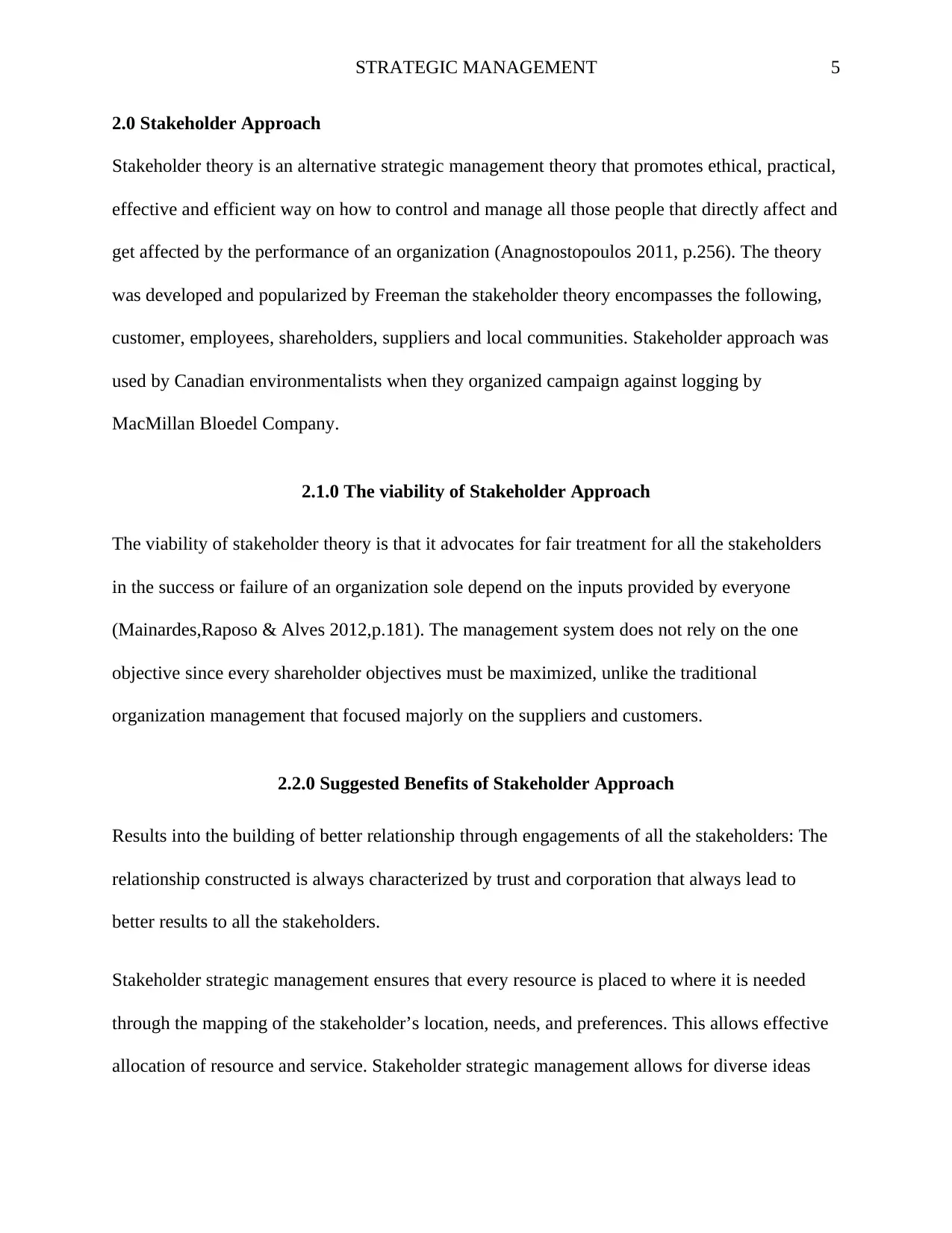
STRATEGIC MANAGEMENT 5
2.0 Stakeholder Approach
Stakeholder theory is an alternative strategic management theory that promotes ethical, practical,
effective and efficient way on how to control and manage all those people that directly affect and
get affected by the performance of an organization (Anagnostopoulos 2011, p.256). The theory
was developed and popularized by Freeman the stakeholder theory encompasses the following,
customer, employees, shareholders, suppliers and local communities. Stakeholder approach was
used by Canadian environmentalists when they organized campaign against logging by
MacMillan Bloedel Company.
2.1.0 The viability of Stakeholder Approach
The viability of stakeholder theory is that it advocates for fair treatment for all the stakeholders
in the success or failure of an organization sole depend on the inputs provided by everyone
(Mainardes,Raposo & Alves 2012,p.181). The management system does not rely on the one
objective since every shareholder objectives must be maximized, unlike the traditional
organization management that focused majorly on the suppliers and customers.
2.2.0 Suggested Benefits of Stakeholder Approach
Results into the building of better relationship through engagements of all the stakeholders: The
relationship constructed is always characterized by trust and corporation that always lead to
better results to all the stakeholders.
Stakeholder strategic management ensures that every resource is placed to where it is needed
through the mapping of the stakeholder’s location, needs, and preferences. This allows effective
allocation of resource and service. Stakeholder strategic management allows for diverse ideas
2.0 Stakeholder Approach
Stakeholder theory is an alternative strategic management theory that promotes ethical, practical,
effective and efficient way on how to control and manage all those people that directly affect and
get affected by the performance of an organization (Anagnostopoulos 2011, p.256). The theory
was developed and popularized by Freeman the stakeholder theory encompasses the following,
customer, employees, shareholders, suppliers and local communities. Stakeholder approach was
used by Canadian environmentalists when they organized campaign against logging by
MacMillan Bloedel Company.
2.1.0 The viability of Stakeholder Approach
The viability of stakeholder theory is that it advocates for fair treatment for all the stakeholders
in the success or failure of an organization sole depend on the inputs provided by everyone
(Mainardes,Raposo & Alves 2012,p.181). The management system does not rely on the one
objective since every shareholder objectives must be maximized, unlike the traditional
organization management that focused majorly on the suppliers and customers.
2.2.0 Suggested Benefits of Stakeholder Approach
Results into the building of better relationship through engagements of all the stakeholders: The
relationship constructed is always characterized by trust and corporation that always lead to
better results to all the stakeholders.
Stakeholder strategic management ensures that every resource is placed to where it is needed
through the mapping of the stakeholder’s location, needs, and preferences. This allows effective
allocation of resource and service. Stakeholder strategic management allows for diverse ideas
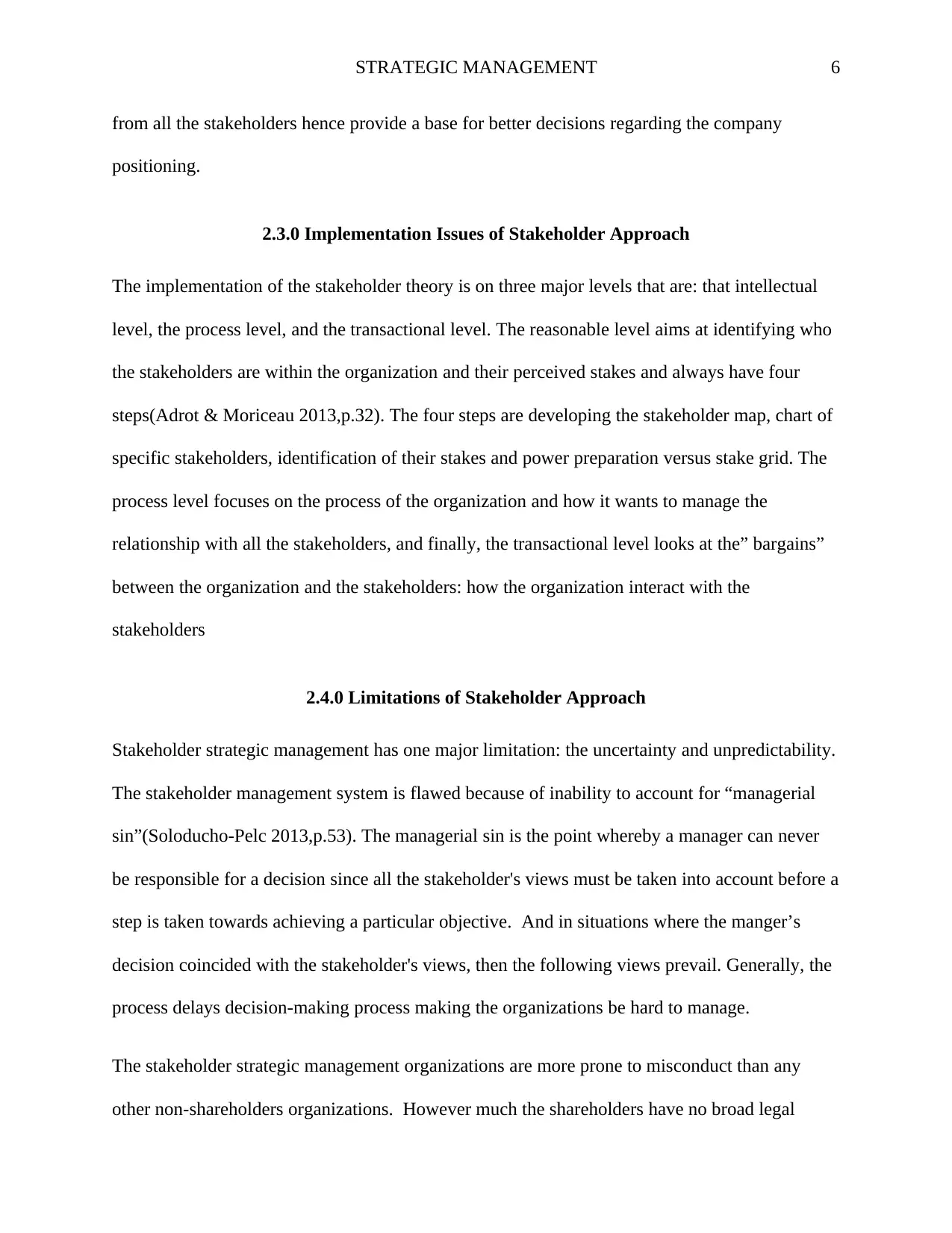
STRATEGIC MANAGEMENT 6
from all the stakeholders hence provide a base for better decisions regarding the company
positioning.
2.3.0 Implementation Issues of Stakeholder Approach
The implementation of the stakeholder theory is on three major levels that are: that intellectual
level, the process level, and the transactional level. The reasonable level aims at identifying who
the stakeholders are within the organization and their perceived stakes and always have four
steps(Adrot & Moriceau 2013,p.32). The four steps are developing the stakeholder map, chart of
specific stakeholders, identification of their stakes and power preparation versus stake grid. The
process level focuses on the process of the organization and how it wants to manage the
relationship with all the stakeholders, and finally, the transactional level looks at the” bargains”
between the organization and the stakeholders: how the organization interact with the
stakeholders
2.4.0 Limitations of Stakeholder Approach
Stakeholder strategic management has one major limitation: the uncertainty and unpredictability.
The stakeholder management system is flawed because of inability to account for “managerial
sin”(Soloducho-Pelc 2013,p.53). The managerial sin is the point whereby a manager can never
be responsible for a decision since all the stakeholder's views must be taken into account before a
step is taken towards achieving a particular objective. And in situations where the manger’s
decision coincided with the stakeholder's views, then the following views prevail. Generally, the
process delays decision-making process making the organizations be hard to manage.
The stakeholder strategic management organizations are more prone to misconduct than any
other non-shareholders organizations. However much the shareholders have no broad legal
from all the stakeholders hence provide a base for better decisions regarding the company
positioning.
2.3.0 Implementation Issues of Stakeholder Approach
The implementation of the stakeholder theory is on three major levels that are: that intellectual
level, the process level, and the transactional level. The reasonable level aims at identifying who
the stakeholders are within the organization and their perceived stakes and always have four
steps(Adrot & Moriceau 2013,p.32). The four steps are developing the stakeholder map, chart of
specific stakeholders, identification of their stakes and power preparation versus stake grid. The
process level focuses on the process of the organization and how it wants to manage the
relationship with all the stakeholders, and finally, the transactional level looks at the” bargains”
between the organization and the stakeholders: how the organization interact with the
stakeholders
2.4.0 Limitations of Stakeholder Approach
Stakeholder strategic management has one major limitation: the uncertainty and unpredictability.
The stakeholder management system is flawed because of inability to account for “managerial
sin”(Soloducho-Pelc 2013,p.53). The managerial sin is the point whereby a manager can never
be responsible for a decision since all the stakeholder's views must be taken into account before a
step is taken towards achieving a particular objective. And in situations where the manger’s
decision coincided with the stakeholder's views, then the following views prevail. Generally, the
process delays decision-making process making the organizations be hard to manage.
The stakeholder strategic management organizations are more prone to misconduct than any
other non-shareholders organizations. However much the shareholders have no broad legal
⊘ This is a preview!⊘
Do you want full access?
Subscribe today to unlock all pages.

Trusted by 1+ million students worldwide

STRATEGIC MANAGEMENT 7
power to initiate corporate action against any misconduct, the decision makings on the
management structure lie upon the board of directors hence affect the management decisions on
rectifying any misconduct.
Shareholder strategic management lacks cohesive, powerful interests unions that play major roles
in advocating for the rights such as those found in non-shareholder. This makes the strategy to
have difficulty in protecting them from the management misconducts.
3.0 Entrepreneurship Opportunistic Approach of strategic management
Entrepreneurship refers to the dynamic process of creating incremental wealth. Thus
Entrepreneur opportunistic is a strategic approach that aims at increasing the profit of an
organization through utilizing any available opportunity (Urbaniec 2018,p. 1776). The approach
was adopted from business headed by a family that managed to thrive against all the odds. The
entrepreneurs always make assumptions about the future and make the best decision in the best
interest of the business. The basic features of entrepreneur approach are: the approach focus on
capitalizing more on the available opportunities than solving problems, therefore the most
important objective is expansion. There are centralized decision-making process and power that
lies on the head of the family. Example of Entrepreneurship Opportunity application is when the
Sony Corporation chairman of AkioMorita insisted on production of Walkman mini-cassette
even after being advised that it was viable, and made a roaring success.
3.1.0 Viability of Entrepreneurship Approach
The entrepreneurship opportunity approach is viable in organizations since organizations with
0nly strategic management and lack entrepreneurship spirit failure are inevitable. The
power to initiate corporate action against any misconduct, the decision makings on the
management structure lie upon the board of directors hence affect the management decisions on
rectifying any misconduct.
Shareholder strategic management lacks cohesive, powerful interests unions that play major roles
in advocating for the rights such as those found in non-shareholder. This makes the strategy to
have difficulty in protecting them from the management misconducts.
3.0 Entrepreneurship Opportunistic Approach of strategic management
Entrepreneurship refers to the dynamic process of creating incremental wealth. Thus
Entrepreneur opportunistic is a strategic approach that aims at increasing the profit of an
organization through utilizing any available opportunity (Urbaniec 2018,p. 1776). The approach
was adopted from business headed by a family that managed to thrive against all the odds. The
entrepreneurs always make assumptions about the future and make the best decision in the best
interest of the business. The basic features of entrepreneur approach are: the approach focus on
capitalizing more on the available opportunities than solving problems, therefore the most
important objective is expansion. There are centralized decision-making process and power that
lies on the head of the family. Example of Entrepreneurship Opportunity application is when the
Sony Corporation chairman of AkioMorita insisted on production of Walkman mini-cassette
even after being advised that it was viable, and made a roaring success.
3.1.0 Viability of Entrepreneurship Approach
The entrepreneurship opportunity approach is viable in organizations since organizations with
0nly strategic management and lack entrepreneurship spirit failure are inevitable. The
Paraphrase This Document
Need a fresh take? Get an instant paraphrase of this document with our AI Paraphraser
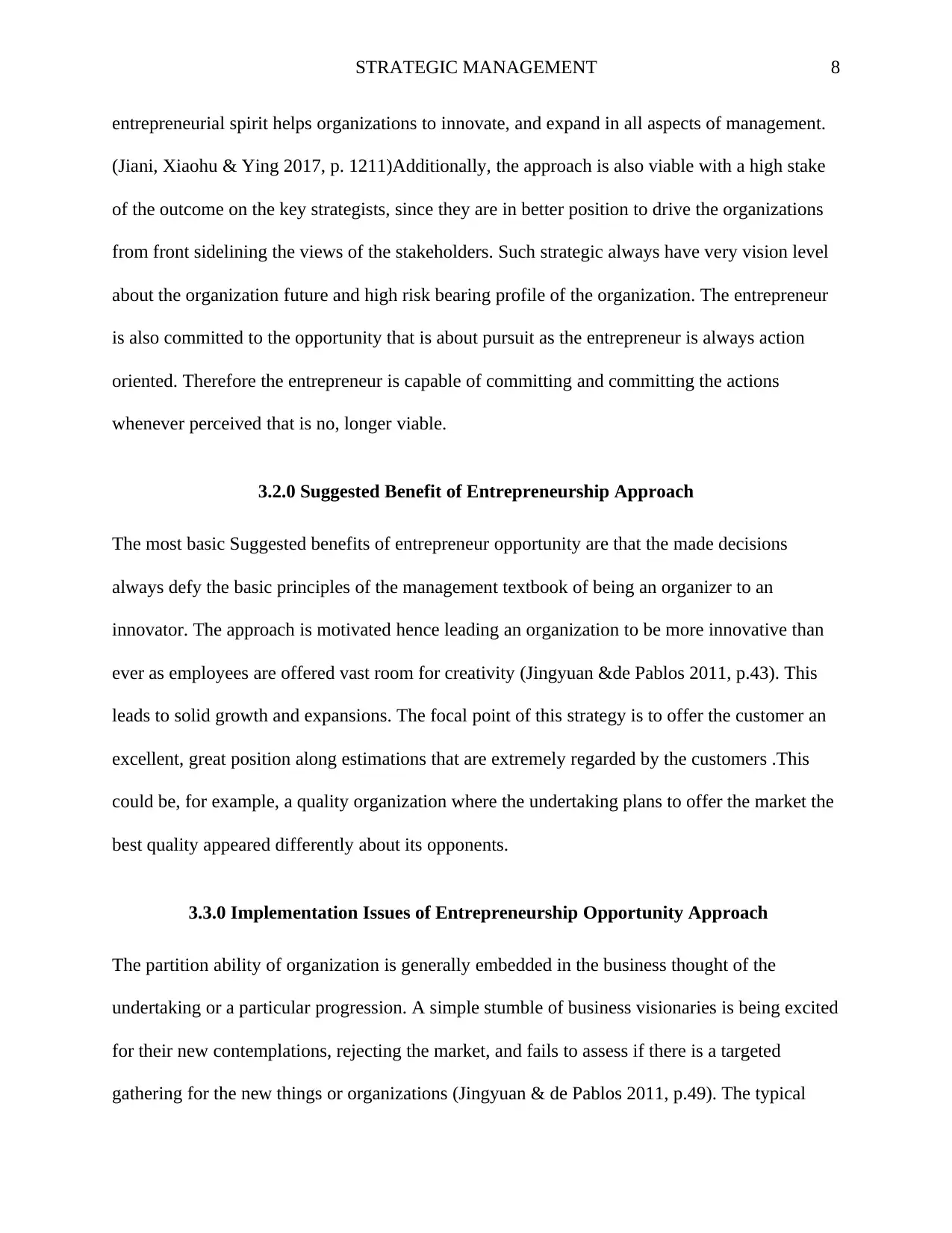
STRATEGIC MANAGEMENT 8
entrepreneurial spirit helps organizations to innovate, and expand in all aspects of management.
(Jiani, Xiaohu & Ying 2017, p. 1211)Additionally, the approach is also viable with a high stake
of the outcome on the key strategists, since they are in better position to drive the organizations
from front sidelining the views of the stakeholders. Such strategic always have very vision level
about the organization future and high risk bearing profile of the organization. The entrepreneur
is also committed to the opportunity that is about pursuit as the entrepreneur is always action
oriented. Therefore the entrepreneur is capable of committing and committing the actions
whenever perceived that is no, longer viable.
3.2.0 Suggested Benefit of Entrepreneurship Approach
The most basic Suggested benefits of entrepreneur opportunity are that the made decisions
always defy the basic principles of the management textbook of being an organizer to an
innovator. The approach is motivated hence leading an organization to be more innovative than
ever as employees are offered vast room for creativity (Jingyuan &de Pablos 2011, p.43). This
leads to solid growth and expansions. The focal point of this strategy is to offer the customer an
excellent, great position along estimations that are extremely regarded by the customers .This
could be, for example, a quality organization where the undertaking plans to offer the market the
best quality appeared differently about its opponents.
3.3.0 Implementation Issues of Entrepreneurship Opportunity Approach
The partition ability of organization is generally embedded in the business thought of the
undertaking or a particular progression. A simple stumble of business visionaries is being excited
for their new contemplations, rejecting the market, and fails to assess if there is a targeted
gathering for the new things or organizations (Jingyuan & de Pablos 2011, p.49). The typical
entrepreneurial spirit helps organizations to innovate, and expand in all aspects of management.
(Jiani, Xiaohu & Ying 2017, p. 1211)Additionally, the approach is also viable with a high stake
of the outcome on the key strategists, since they are in better position to drive the organizations
from front sidelining the views of the stakeholders. Such strategic always have very vision level
about the organization future and high risk bearing profile of the organization. The entrepreneur
is also committed to the opportunity that is about pursuit as the entrepreneur is always action
oriented. Therefore the entrepreneur is capable of committing and committing the actions
whenever perceived that is no, longer viable.
3.2.0 Suggested Benefit of Entrepreneurship Approach
The most basic Suggested benefits of entrepreneur opportunity are that the made decisions
always defy the basic principles of the management textbook of being an organizer to an
innovator. The approach is motivated hence leading an organization to be more innovative than
ever as employees are offered vast room for creativity (Jingyuan &de Pablos 2011, p.43). This
leads to solid growth and expansions. The focal point of this strategy is to offer the customer an
excellent, great position along estimations that are extremely regarded by the customers .This
could be, for example, a quality organization where the undertaking plans to offer the market the
best quality appeared differently about its opponents.
3.3.0 Implementation Issues of Entrepreneurship Opportunity Approach
The partition ability of organization is generally embedded in the business thought of the
undertaking or a particular progression. A simple stumble of business visionaries is being excited
for their new contemplations, rejecting the market, and fails to assess if there is a targeted
gathering for the new things or organizations (Jingyuan & de Pablos 2011, p.49). The typical
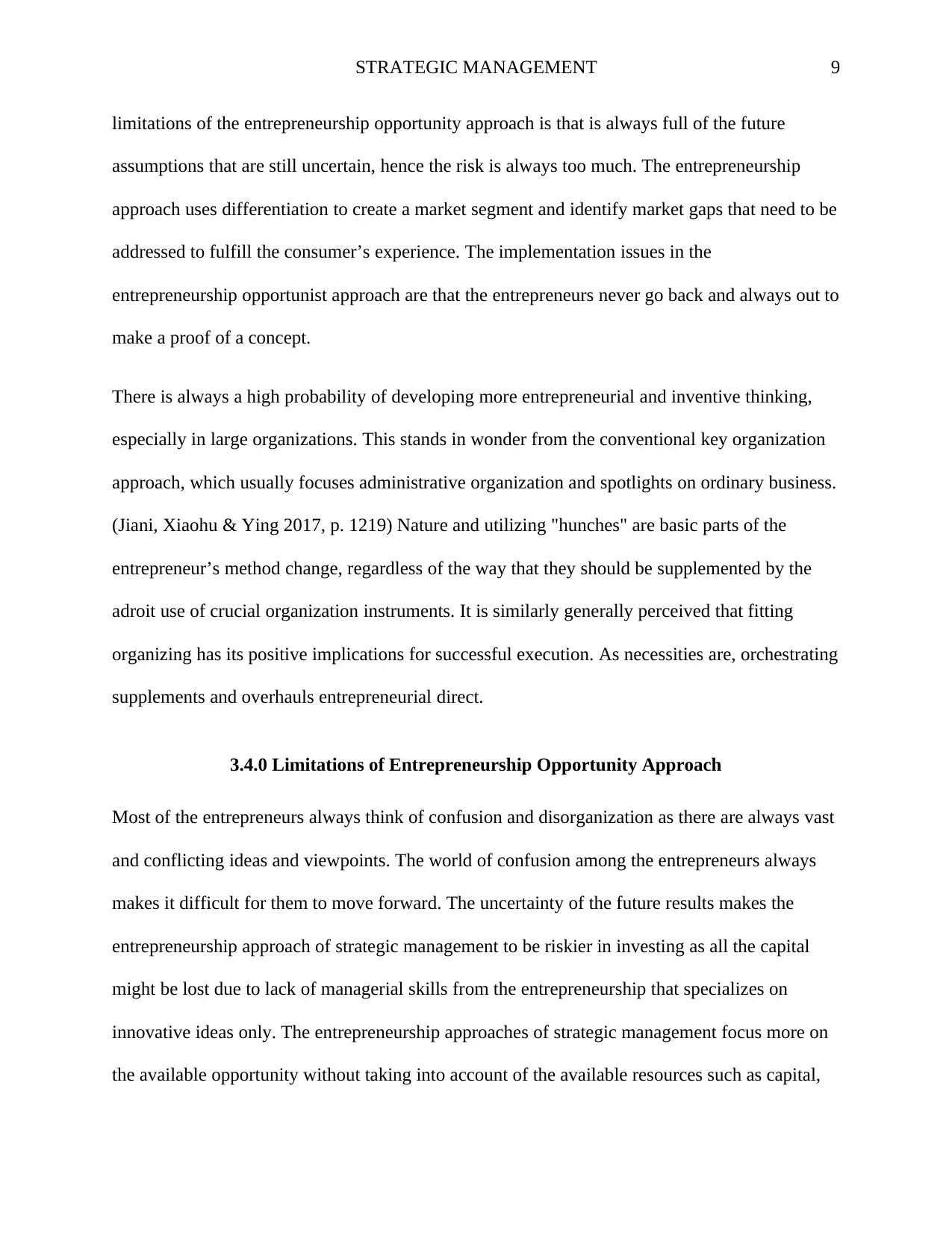
STRATEGIC MANAGEMENT 9
limitations of the entrepreneurship opportunity approach is that is always full of the future
assumptions that are still uncertain, hence the risk is always too much. The entrepreneurship
approach uses differentiation to create a market segment and identify market gaps that need to be
addressed to fulfill the consumer’s experience. The implementation issues in the
entrepreneurship opportunist approach are that the entrepreneurs never go back and always out to
make a proof of a concept.
There is always a high probability of developing more entrepreneurial and inventive thinking,
especially in large organizations. This stands in wonder from the conventional key organization
approach, which usually focuses administrative organization and spotlights on ordinary business.
(Jiani, Xiaohu & Ying 2017, p. 1219) Nature and utilizing "hunches" are basic parts of the
entrepreneur’s method change, regardless of the way that they should be supplemented by the
adroit use of crucial organization instruments. It is similarly generally perceived that fitting
organizing has its positive implications for successful execution. As necessities are, orchestrating
supplements and overhauls entrepreneurial direct.
3.4.0 Limitations of Entrepreneurship Opportunity Approach
Most of the entrepreneurs always think of confusion and disorganization as there are always vast
and conflicting ideas and viewpoints. The world of confusion among the entrepreneurs always
makes it difficult for them to move forward. The uncertainty of the future results makes the
entrepreneurship approach of strategic management to be riskier in investing as all the capital
might be lost due to lack of managerial skills from the entrepreneurship that specializes on
innovative ideas only. The entrepreneurship approaches of strategic management focus more on
the available opportunity without taking into account of the available resources such as capital,
limitations of the entrepreneurship opportunity approach is that is always full of the future
assumptions that are still uncertain, hence the risk is always too much. The entrepreneurship
approach uses differentiation to create a market segment and identify market gaps that need to be
addressed to fulfill the consumer’s experience. The implementation issues in the
entrepreneurship opportunist approach are that the entrepreneurs never go back and always out to
make a proof of a concept.
There is always a high probability of developing more entrepreneurial and inventive thinking,
especially in large organizations. This stands in wonder from the conventional key organization
approach, which usually focuses administrative organization and spotlights on ordinary business.
(Jiani, Xiaohu & Ying 2017, p. 1219) Nature and utilizing "hunches" are basic parts of the
entrepreneur’s method change, regardless of the way that they should be supplemented by the
adroit use of crucial organization instruments. It is similarly generally perceived that fitting
organizing has its positive implications for successful execution. As necessities are, orchestrating
supplements and overhauls entrepreneurial direct.
3.4.0 Limitations of Entrepreneurship Opportunity Approach
Most of the entrepreneurs always think of confusion and disorganization as there are always vast
and conflicting ideas and viewpoints. The world of confusion among the entrepreneurs always
makes it difficult for them to move forward. The uncertainty of the future results makes the
entrepreneurship approach of strategic management to be riskier in investing as all the capital
might be lost due to lack of managerial skills from the entrepreneurship that specializes on
innovative ideas only. The entrepreneurship approaches of strategic management focus more on
the available opportunity without taking into account of the available resources such as capital,
⊘ This is a preview!⊘
Do you want full access?
Subscribe today to unlock all pages.

Trusted by 1+ million students worldwide
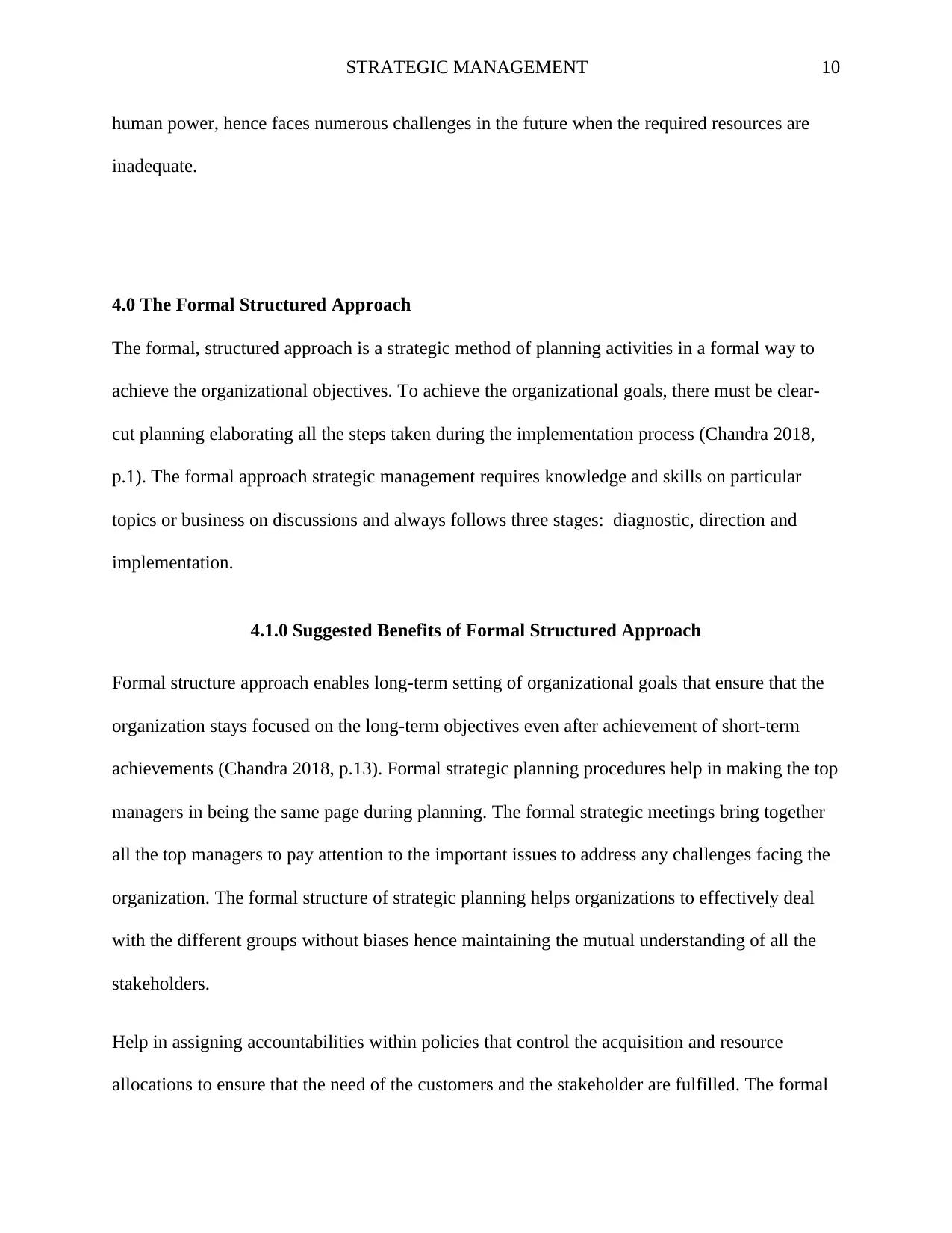
STRATEGIC MANAGEMENT 10
human power, hence faces numerous challenges in the future when the required resources are
inadequate.
4.0 The Formal Structured Approach
The formal, structured approach is a strategic method of planning activities in a formal way to
achieve the organizational objectives. To achieve the organizational goals, there must be clear-
cut planning elaborating all the steps taken during the implementation process (Chandra 2018,
p.1). The formal approach strategic management requires knowledge and skills on particular
topics or business on discussions and always follows three stages: diagnostic, direction and
implementation.
4.1.0 Suggested Benefits of Formal Structured Approach
Formal structure approach enables long-term setting of organizational goals that ensure that the
organization stays focused on the long-term objectives even after achievement of short-term
achievements (Chandra 2018, p.13). Formal strategic planning procedures help in making the top
managers in being the same page during planning. The formal strategic meetings bring together
all the top managers to pay attention to the important issues to address any challenges facing the
organization. The formal structure of strategic planning helps organizations to effectively deal
with the different groups without biases hence maintaining the mutual understanding of all the
stakeholders.
Help in assigning accountabilities within policies that control the acquisition and resource
allocations to ensure that the need of the customers and the stakeholder are fulfilled. The formal
human power, hence faces numerous challenges in the future when the required resources are
inadequate.
4.0 The Formal Structured Approach
The formal, structured approach is a strategic method of planning activities in a formal way to
achieve the organizational objectives. To achieve the organizational goals, there must be clear-
cut planning elaborating all the steps taken during the implementation process (Chandra 2018,
p.1). The formal approach strategic management requires knowledge and skills on particular
topics or business on discussions and always follows three stages: diagnostic, direction and
implementation.
4.1.0 Suggested Benefits of Formal Structured Approach
Formal structure approach enables long-term setting of organizational goals that ensure that the
organization stays focused on the long-term objectives even after achievement of short-term
achievements (Chandra 2018, p.13). Formal strategic planning procedures help in making the top
managers in being the same page during planning. The formal strategic meetings bring together
all the top managers to pay attention to the important issues to address any challenges facing the
organization. The formal structure of strategic planning helps organizations to effectively deal
with the different groups without biases hence maintaining the mutual understanding of all the
stakeholders.
Help in assigning accountabilities within policies that control the acquisition and resource
allocations to ensure that the need of the customers and the stakeholder are fulfilled. The formal
Paraphrase This Document
Need a fresh take? Get an instant paraphrase of this document with our AI Paraphraser
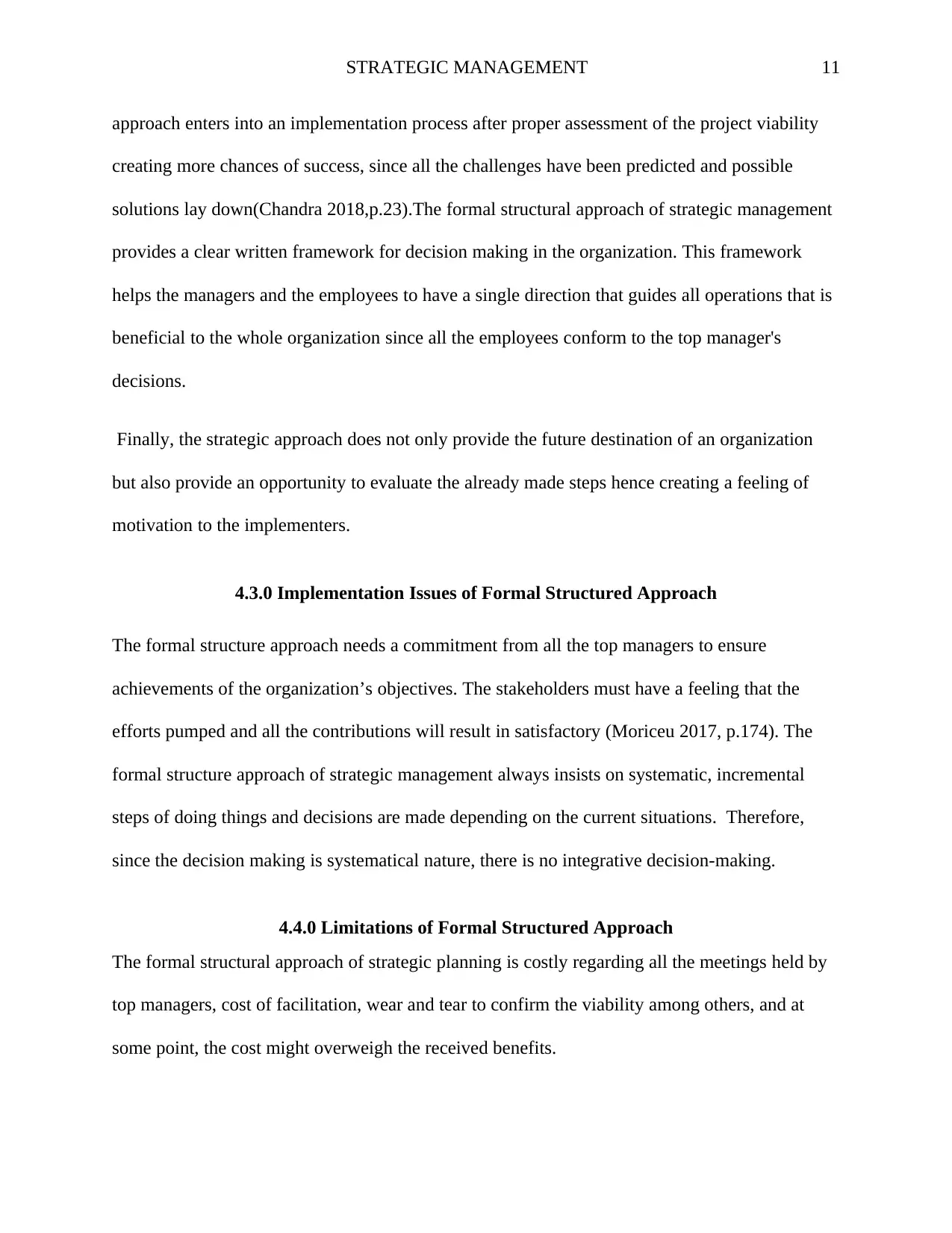
STRATEGIC MANAGEMENT 11
approach enters into an implementation process after proper assessment of the project viability
creating more chances of success, since all the challenges have been predicted and possible
solutions lay down(Chandra 2018,p.23).The formal structural approach of strategic management
provides a clear written framework for decision making in the organization. This framework
helps the managers and the employees to have a single direction that guides all operations that is
beneficial to the whole organization since all the employees conform to the top manager's
decisions.
Finally, the strategic approach does not only provide the future destination of an organization
but also provide an opportunity to evaluate the already made steps hence creating a feeling of
motivation to the implementers.
4.3.0 Implementation Issues of Formal Structured Approach
The formal structure approach needs a commitment from all the top managers to ensure
achievements of the organization’s objectives. The stakeholders must have a feeling that the
efforts pumped and all the contributions will result in satisfactory (Moriceu 2017, p.174). The
formal structure approach of strategic management always insists on systematic, incremental
steps of doing things and decisions are made depending on the current situations. Therefore,
since the decision making is systematical nature, there is no integrative decision-making.
4.4.0 Limitations of Formal Structured Approach
The formal structural approach of strategic planning is costly regarding all the meetings held by
top managers, cost of facilitation, wear and tear to confirm the viability among others, and at
some point, the cost might overweigh the received benefits.
approach enters into an implementation process after proper assessment of the project viability
creating more chances of success, since all the challenges have been predicted and possible
solutions lay down(Chandra 2018,p.23).The formal structural approach of strategic management
provides a clear written framework for decision making in the organization. This framework
helps the managers and the employees to have a single direction that guides all operations that is
beneficial to the whole organization since all the employees conform to the top manager's
decisions.
Finally, the strategic approach does not only provide the future destination of an organization
but also provide an opportunity to evaluate the already made steps hence creating a feeling of
motivation to the implementers.
4.3.0 Implementation Issues of Formal Structured Approach
The formal structure approach needs a commitment from all the top managers to ensure
achievements of the organization’s objectives. The stakeholders must have a feeling that the
efforts pumped and all the contributions will result in satisfactory (Moriceu 2017, p.174). The
formal structure approach of strategic management always insists on systematic, incremental
steps of doing things and decisions are made depending on the current situations. Therefore,
since the decision making is systematical nature, there is no integrative decision-making.
4.4.0 Limitations of Formal Structured Approach
The formal structural approach of strategic planning is costly regarding all the meetings held by
top managers, cost of facilitation, wear and tear to confirm the viability among others, and at
some point, the cost might overweigh the received benefits.

STRATEGIC MANAGEMENT 12
The need to incorporate all members in the formal structural approach of strategic management
can be interpreted as the need to close down the business entirely during the process or to ask
inappropriate staff to participate. This eventually results in either confusion or resentment.
The Formal Structured Approach of strategic management impedes flexibility of an organization;
hence it is very impossible for utilization of unexpected opportunities that might be beneficial to
the organization in the short run. This because the operations and the activities of such
organizations are well structured and waving away from them is perceived as unprofessional
behavior.
Another way that flexibility can be blocked is through a top-notch course of action and blend of
the procedure inside the affiliation. An affiliation that is all around agreed with its approach has
kept an eye on its structure, board, staffing, and execution and reward systems. This course of
action ensures that the whole affiliation is pulling the right way, yet can block the affiliation's
adaptability(Gongia 2012,p.52). Again, there are groupings of more present approaches to
manage framework headway used as a piece of the separate division that build method and
address the issues of definitive adaptability. Finally, the formal, structured Approach of Strategic
management is always designed for long-term benefit; hence it makes it difficult for the
organization to evaluate the short-term before the full achievement of the goals.
5.0 Conclusion
Strategic management is the most preferred way of organizational management in the current era
of business. The system outweighs the traditional management system since it takes into account
all the process of production from the raw material, workers, customers, suppliers, and any other
stakeholder that is directly or indirectly affect and get affected by the success of the organization.
The need to incorporate all members in the formal structural approach of strategic management
can be interpreted as the need to close down the business entirely during the process or to ask
inappropriate staff to participate. This eventually results in either confusion or resentment.
The Formal Structured Approach of strategic management impedes flexibility of an organization;
hence it is very impossible for utilization of unexpected opportunities that might be beneficial to
the organization in the short run. This because the operations and the activities of such
organizations are well structured and waving away from them is perceived as unprofessional
behavior.
Another way that flexibility can be blocked is through a top-notch course of action and blend of
the procedure inside the affiliation. An affiliation that is all around agreed with its approach has
kept an eye on its structure, board, staffing, and execution and reward systems. This course of
action ensures that the whole affiliation is pulling the right way, yet can block the affiliation's
adaptability(Gongia 2012,p.52). Again, there are groupings of more present approaches to
manage framework headway used as a piece of the separate division that build method and
address the issues of definitive adaptability. Finally, the formal, structured Approach of Strategic
management is always designed for long-term benefit; hence it makes it difficult for the
organization to evaluate the short-term before the full achievement of the goals.
5.0 Conclusion
Strategic management is the most preferred way of organizational management in the current era
of business. The system outweighs the traditional management system since it takes into account
all the process of production from the raw material, workers, customers, suppliers, and any other
stakeholder that is directly or indirectly affect and get affected by the success of the organization.
⊘ This is a preview!⊘
Do you want full access?
Subscribe today to unlock all pages.

Trusted by 1+ million students worldwide
1 out of 16
Related Documents
Your All-in-One AI-Powered Toolkit for Academic Success.
+13062052269
info@desklib.com
Available 24*7 on WhatsApp / Email
![[object Object]](/_next/static/media/star-bottom.7253800d.svg)
Unlock your academic potential
Copyright © 2020–2025 A2Z Services. All Rights Reserved. Developed and managed by ZUCOL.




